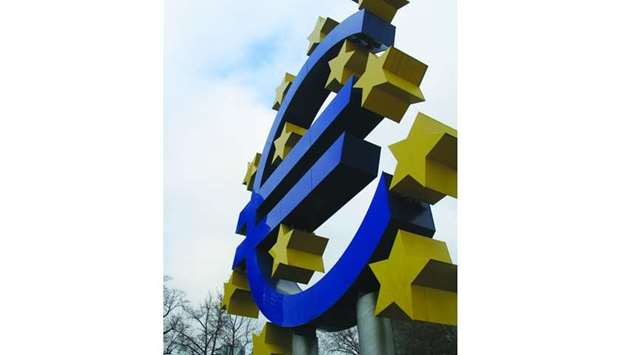The divergence in performance across the euro area is a serious problem for policymakers and the European Central Bank (ECB) in particular, QNB has said in an economic commentary.
Euro area real GDP growth has fallen to just 1.1% year-on-year (y-o-y) in Q2, 2019, the slowest pace of expansion since 2014 when the euro area began to recover from the sovereign debt crisis.


“We raised concerns about the weakness of economic growth in the euro area last year. This weakness has continued and forced the ECB to give up on pressing ahead with policy normalisation. Now, Despite various constrains, we believe that the ECB must be putting together a comprehensive package of monetary stimulus to be announced at its September meeting,” QNB said.
In the commentary, QNB considers the divergence in economic performance within the euro area. First, it looks at the divergence between the manufacturing and services sectors and then the divergence between core countries (e.g., France and Germany) and periphery countries (e.g., Spain and Italy).
The Purchasing Managers Index is one of the most widely used leading indicators of economic activity. It is based on surveys sent to managers at a large sample of companies across the economy. They are asked to rate the outlook for the next three months relative to the past three months.
The survey response is then compiled into a so-called diffusion index where a number above 50 indicates that output is growing and below 50 that output is contracting.
At 46.5 in July, the manufacturing PMI for the euro area as a whole has fallen further below 50, indicating contraction in the manufacturing sector. The euro area manufacturing PMI peaked at over 60 in December 2017 as the sector was driven by a favourable combination of strong global demand growth and a weak currency (euro averaging only 1.10 USD per EUR between April 2015 and April 2017).
However, the continued escalation of the trade war between the US and China and a stronger currency (euro averaging 1.16 Since May 2017) have put the brakes on the euro area manufacturing sector. Further headwinds have come from tighter emissions standards and the risk of a “no-deal” Brexit.
“The end result is that the manufacturing sector has switched from being the engine of growth for the euro area to a bit of a liability when there is a trade war going on between two of its largest customers,” QNB said.
Labour markets across the euro area have more-or-less recovered from their weakness during the sovereign debt crisis; however the divergence between countries is clear, with periphery countries still much weaker than core countries.
This strength in the labour market, QNB noted, has allowed wages to grow at the fastest rate in a decade and supported domestic demand in the euro area. Domestic demand tends to be skewed towards services, which has kept the services PMI above 50 at 53.1 in July, indicating continued expansion.
Despite this, there are early signs that the weakness in manufacturing is beginning to spill over into weaker domestic demand and services.
“We have already seen the divergence in unemployment rates between euro area countries, but it is also apparent in the growth of the whole economy. The worst performing of the big-four economies within the Euro area is Italy, which is suffering from deep structural problems and very high levels of government debt. Italy’s economy is the only major euro area economy which is still producing less output than before the 2009 global financial crisis (GFC). Indeed, Italy is still the worst performing of the big-four euro area economies, with zero growth so far in 2019,” QNB said.
The other large euro area country that suffered during the 2013 sovereign debt crisis was Spain, where the main problem is chronic unemployment and particularly youth unemployment. However, Spain went into the 2009 GFC with the lowest level of government debt of the big-four, which has helped prevent its debt-to-GDP ratio rising above 100%.
In addition, QNB said structural reforms and the recapitalisation of its troubled banking system undertaken during the 2013 sovereign debt crisis have supported an impressive recovery in the Spanish economy. The level of GDP is now back above its pre-GFC level and Spanish economy is currently the only one of the big-four that is growing at a rate above 2% y-o-y.
The French economy is not without problems, but has been by far the most stable of the big-four; with modestly above average performance across all the metrics QNB has considered.
The German economy, it said stands out as the best performer of the big-four, thanks to its world-class manufacturing sector. The German economy is now 15% larger than it was in 2007, the unemployment rate is currently only 3.1% and the German government can effectively borrow at an interest rate of zero over the next 10 years.
“That is all well and good, but the German economy is the big-four economy that is most exposed to the weakness in external demand that we are seeing as a result of the trade war,” QNB said.
This divergence in performance across the Euro area is a serious problem for policy makers and the ECB in particular. It results in a number of constraints on the ability of the ECB to implement monetary policy that is appropriate for the euro area as a whole. For example, there is not enough German government debt for the ECB to buy and too much Italian debt. And, inevitably hard-working Germans are understandably reluctant to take on the burden of Italian debt, QNB said.


“We raised concerns about the weakness of economic growth in the euro area last year. This weakness has continued and forced the ECB to give up on pressing ahead with policy normalisation. Now, Despite various constrains, we believe that the ECB must be putting together a comprehensive package of monetary stimulus to be announced at its September meeting,” QNB said.
In the commentary, QNB considers the divergence in economic performance within the euro area. First, it looks at the divergence between the manufacturing and services sectors and then the divergence between core countries (e.g., France and Germany) and periphery countries (e.g., Spain and Italy).
The Purchasing Managers Index is one of the most widely used leading indicators of economic activity. It is based on surveys sent to managers at a large sample of companies across the economy. They are asked to rate the outlook for the next three months relative to the past three months.
The survey response is then compiled into a so-called diffusion index where a number above 50 indicates that output is growing and below 50 that output is contracting.
At 46.5 in July, the manufacturing PMI for the euro area as a whole has fallen further below 50, indicating contraction in the manufacturing sector. The euro area manufacturing PMI peaked at over 60 in December 2017 as the sector was driven by a favourable combination of strong global demand growth and a weak currency (euro averaging only 1.10 USD per EUR between April 2015 and April 2017).
However, the continued escalation of the trade war between the US and China and a stronger currency (euro averaging 1.16 Since May 2017) have put the brakes on the euro area manufacturing sector. Further headwinds have come from tighter emissions standards and the risk of a “no-deal” Brexit.
“The end result is that the manufacturing sector has switched from being the engine of growth for the euro area to a bit of a liability when there is a trade war going on between two of its largest customers,” QNB said.
Labour markets across the euro area have more-or-less recovered from their weakness during the sovereign debt crisis; however the divergence between countries is clear, with periphery countries still much weaker than core countries.
This strength in the labour market, QNB noted, has allowed wages to grow at the fastest rate in a decade and supported domestic demand in the euro area. Domestic demand tends to be skewed towards services, which has kept the services PMI above 50 at 53.1 in July, indicating continued expansion.
Despite this, there are early signs that the weakness in manufacturing is beginning to spill over into weaker domestic demand and services.
“We have already seen the divergence in unemployment rates between euro area countries, but it is also apparent in the growth of the whole economy. The worst performing of the big-four economies within the Euro area is Italy, which is suffering from deep structural problems and very high levels of government debt. Italy’s economy is the only major euro area economy which is still producing less output than before the 2009 global financial crisis (GFC). Indeed, Italy is still the worst performing of the big-four euro area economies, with zero growth so far in 2019,” QNB said.
The other large euro area country that suffered during the 2013 sovereign debt crisis was Spain, where the main problem is chronic unemployment and particularly youth unemployment. However, Spain went into the 2009 GFC with the lowest level of government debt of the big-four, which has helped prevent its debt-to-GDP ratio rising above 100%.
In addition, QNB said structural reforms and the recapitalisation of its troubled banking system undertaken during the 2013 sovereign debt crisis have supported an impressive recovery in the Spanish economy. The level of GDP is now back above its pre-GFC level and Spanish economy is currently the only one of the big-four that is growing at a rate above 2% y-o-y.
The French economy is not without problems, but has been by far the most stable of the big-four; with modestly above average performance across all the metrics QNB has considered.
The German economy, it said stands out as the best performer of the big-four, thanks to its world-class manufacturing sector. The German economy is now 15% larger than it was in 2007, the unemployment rate is currently only 3.1% and the German government can effectively borrow at an interest rate of zero over the next 10 years.
“That is all well and good, but the German economy is the big-four economy that is most exposed to the weakness in external demand that we are seeing as a result of the trade war,” QNB said.
This divergence in performance across the Euro area is a serious problem for policy makers and the ECB in particular. It results in a number of constraints on the ability of the ECB to implement monetary policy that is appropriate for the euro area as a whole. For example, there is not enough German government debt for the ECB to buy and too much Italian debt. And, inevitably hard-working Germans are understandably reluctant to take on the burden of Italian debt, QNB said.



